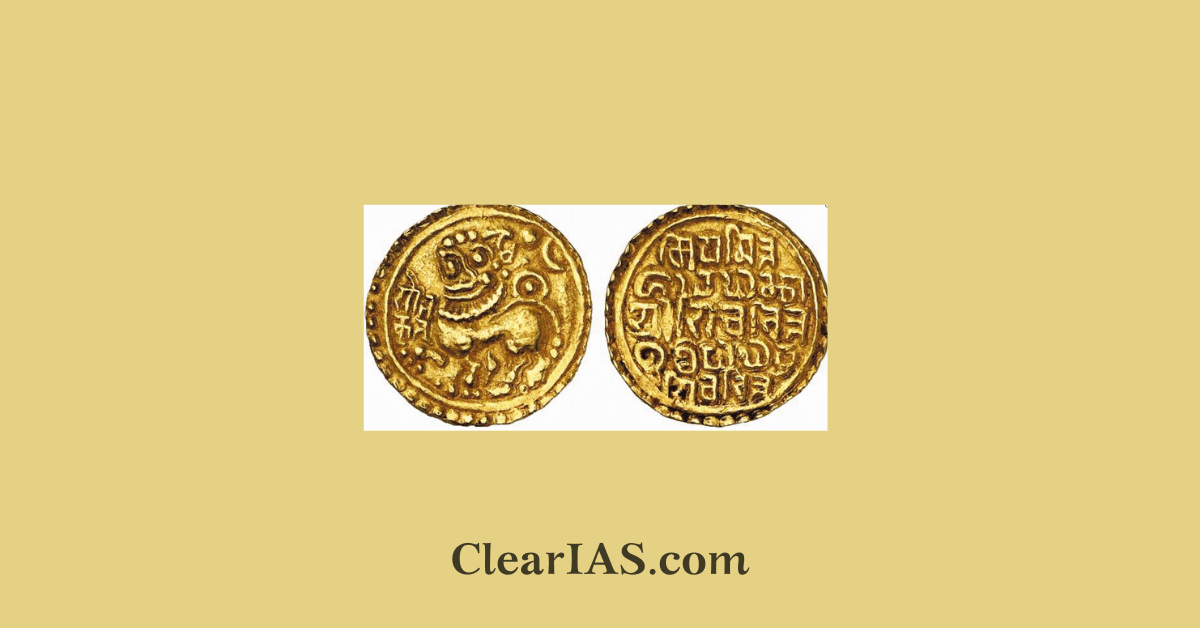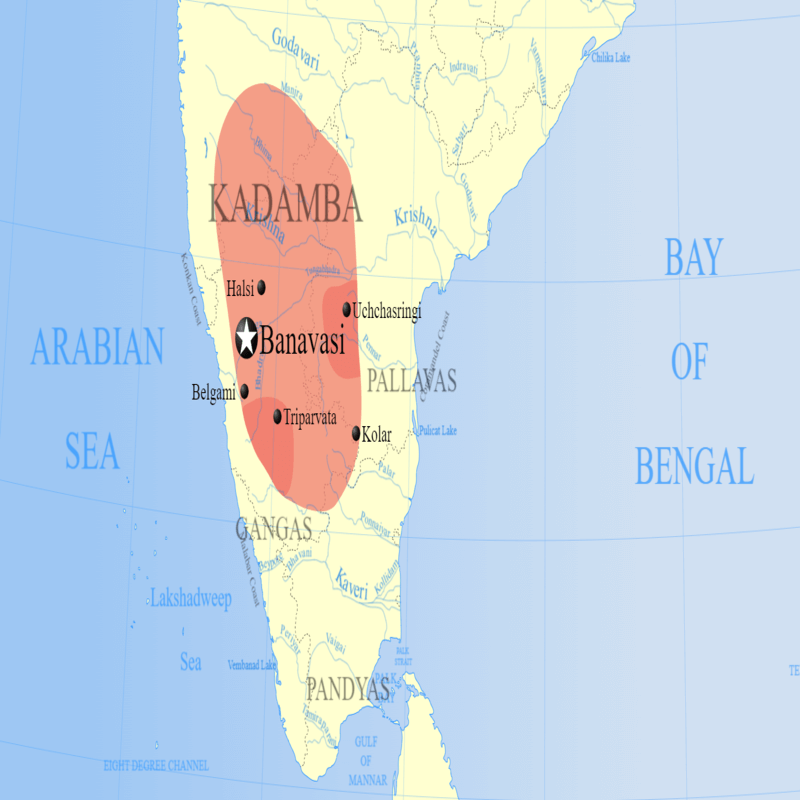
The Kadamba dynasty was an ancient Indian dynasty that ruled over parts of South India, particularly the present-day Karnataka region, from the 4th to the 6th centuries CE. The dynasty is known for its contributions to early South Indian history and culture. Read here to learn more about the dynasty.
An ancient Karnataka royal dynasty known as the Kadamba Dynasty (345–525 CE) governed from Banavasi in the modern Uttara Kannada region.
Later, the dynasty ruled as a feudatory of the Chalukya, Rashtrakuta, and greater Kannada empires for more than 500 years, during which time they expanded into Goa and Hanagal.
It is one of the earliest recorded dynasties in the history of the Deccan region. The dynasty’s rule is thought to have lasted from around the 4th century CE to the 6th century CE.
Kadamba dynasty
The Kadamba dynasty is believed to have been founded by Mayurasharma, who was originally a feudatory of the Pallavas, a prominent dynasty of South India.
According to legend, he established the Kadamba dynasty after defeating the Pallavas.
The early capital of the Kadamba dynasty was Banavasi, located in present-day Karnataka. Later, the capital was shifted to Vaijayanti (modern-day Banavasi).
- Under the leadership of the Kadamba kings, the dynasty expanded its influence in the Western Deccan region, encompassing parts of modern Karnataka, Goa, and Maharashtra.
- Mayurasharma and his successors successfully resisted invasions by the Chalukyas and the Pallavas.
Rulers of Kadamba dynasty

- Mayurasharma: Mayurasharma is traditionally regarded as the founder of the Kadamba dynasty. He is said to have established the dynasty in the early 4th century CE. His reign marked the beginning of the Kadamba rule in the region.
- Kakusthavarma I: Kakusthavarma I succeeded Mayurasharma as a ruler of the Kadamba dynasty. During his reign, the Kadambas expanded their territory and influence in the southern Deccan.
- Kakusthavarma II: Kakusthavarma II was another significant ruler of the Kadamba dynasty. His reign is noted for its contributions to literature and the arts. He is said to have patronized poets and scholars.
- Shantivarman: Shantivarman is believed to have been one of the later rulers of the Kadamba dynasty. His reign is associated with the propagation of Jainism in the region.
- Shivakoti: Shivakoti was another prominent ruler of the Kadamba dynasty. His rule saw the continuation of the dynasty’s influence and territorial expansion.
- Ravivarma: Ravivarma (485 CE) was able to build the kingdom back to its original might during a long rule lasting up to 519 CE. His rule was marked by internal conflicts and clashes with the Pallavas and Gangas. He defeated the Vakatakas as well.
- Harivarman: Harivarman is one of the last known rulers of the Kadamba dynasty. His reign marked a period of decline for the dynasty, and it is suggested that the dynasty eventually succumbed to the influence of the Chalukya dynasty.
In the 10th century CE, a revival of the Kadamba dynasty occurred under the ruler Kadamba Jayakeśi. However, this revival did not lead to a significant resurgence of the dynasty’s power.
Kadambas of Goa
The Kadambas of Goa was an offshoot of the earliest Kadamba family of Karnataka, the Kadambas of Banaväsi who ruled between the 4th and 6th centuries CE.
The Kadambas were allies of the Chalukyas, whom they aided in defeating the Rashtrakutas, according to the Savai vere inscription.
- With the rise of Chalukyas of Badami they lost their imperial status and some members of the family migrated to different places and served as subordinates of the imperial rulers.
- Later, in 960 CE, Shashthadeva defeated the Shilaharas at Chandrapur and founded the Goan Kadamba dynasty.
- The Kadambas of Goa were one such family who were feudatories under the Chalukyas of Kalyani and continued to serve the subsequent ruling families.
- Though feudatories, they almost enjoyed a regal status with their administrative system in their jurisdiction which covered Goa and almost the whole of Dharwad and Belgaum districts of Karnataka.
Administration, Religion, and Culture
The Kadamba kings, like their predecessors the Satavahanas, called themselves Dharmamaharajas and followed them closely in their administrative procedures.
- The kings were well read and some were even scholars and men of letters.
- Inscriptions describe the founding king Mayurasharma as “Vedangavaidya Sharada” (“master of the Vedas”), Vishnuvarma was known for his proficiency in grammar and logic, and Simhavarma was called “skilled in the art of learning”.
The kingdom was divided into provinces or regions, each governed by local chieftains or nobles who were usually related to the ruling family.
- The kingdom was divided into provinces (Mandalasor Desha). Under a province was a district (Vishayas), nine of which have been identified by Panchamukhi.
- Under a district was a Taluk (Mahagramas) comprising numerous villages under which were the villages in groups of ten (Dashagrama).
- The smallest unit was the village (Grama) which appears to have enjoyed particular freedoms under the authority of the headman (Gramika).
- The provincial governors, known as Mahamandaleshvaras, enjoyed a degree of autonomy in their respective regions.
- Land revenue was a significant source of income for the Kadamba dynasty. Revenue officials, known as Amatyas or revenue officers, were responsible for collecting taxes and ensuring the proper administration of revenue.
Several important positions of government were identified:
- The prime minister (Pradhana)
- steward of household (Manevergade)
- Secretary of the council (Tantrapalaor Sabhakarya Sachiva)
- scholarly elders (Vidyavriddhas)
- physician (Deshamatya)
- private secretary (Rahasyadhikritha)
- chief secretary (Sarvakaryakarta)
- chief justice (Dharmadhyaksha) above who was the king himself
- other officials (Bhojakaand Ayukta)
- revenue officers (Rajjukas)
- the writers and scribes (Lekhakas)
The Kadamba dynasty is associated with the patronage of Jainism and Brahmanism. Kadamba rulers supported both religious traditions.
- They made contributions to literature and art, with notable works composed during their rule.
Inscriptions in the Kannada language were used to record royal decrees and achievements. These inscriptions provide valuable historical information about the Kadamba dynasty.
Architecture
The dynasty is primarily associated with the Kadamba style of architecture, characterized by its distinctive features.
- The Kadambas are credited with the creation of several cave temples in the Western Ghats region, particularly in present-day Karnataka.
- The cave temples were hewn out of solid rock, and they often consisted of a sanctum sanctorum (garbhagriha), a hall (mandapa), and sometimes a separate shrine for Nandi, the bull associated with Lord Shiva.
- The most famous example of Kadamba rock-cut architecture is the cave temple at Arvalem (Harvalem) in Goa, dedicated to Lord Shiva. It features intricate carvings and sculptures on the pillars and walls.
Kadamba temple architecture evolved from rock-cut cave temples to structural temples constructed using stone and brick.
- Temples often followed a trikuta (three-shrined) or ekakuta (single-shrined) plan, with a shikhara (tower) over the sanctum sanctorum.
- The Kadamba shikhara (tower) is a distinct feature of their temple architecture. It is pyramidal and typically rises above the sanctum.
- These shikhara are relatively simple compared to the more ornate and elaborate shikhara seen in later Dravidian and Nagara styles of temple architecture.
Kadamba style of architecture contributed to the development of the Dravidian temple architecture style, which is prominent in the South Indian states of Tamil Nadu and Karnataka.
Decline of Kadamba dynasty
The Kadamba dynasty gradually declined in the 6th century CE. Various factors, including internal conflicts, external invasions, and the rise of other regional powers, contributed to its decline.
- The rise of Chalukyas and Rashtrakutas was another major factor, wherein the Kadamba capital was later taken by the Chalukyas.
Despite its relatively short duration, the Kadamba dynasty left a lasting legacy in South Indian history. It contributed to the development of early Dravidian architecture and art.
The dynasty’s inscriptions and coins provide valuable historical and epigraphic records.
The Kadamba dynasty is an important chapter in the history of South India, representing a period of regional power and cultural development. It played a role in shaping the historical and cultural landscape of Karnataka and the surrounding regions.
-Article by Swathi Satish






Leave a Reply